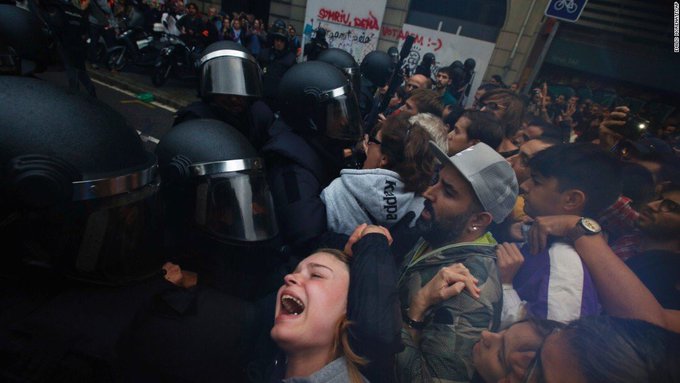Tuesday, October 31, 2017
"The Internet is My Religion"
Intensely personal 2011 speech from Brave New Films' Jim Gilliam (who was raised a conservative Christian evangelical) discussing how the Internet offered him salvation and literally saved his life.
Journalistic Values at AOL?
Soon after AOL announced its merger with HuffingtonPost in February, 2011 Business Insider (followed by the Boston Globe) published leaked AOL documents offering a glimpse into that company's journalistic approach -- not one that Arianna Huffington would endorse. Indeed, it's an approach that violates journalistic ethics. (H/t to former indy media student Leah T, for posting the Insider's summary of AOL's guidelines.)
Web Censorship in China
Google and Yahoo disappeared Chinese dissident Guo Quan, which preceded his 10-year imprisonment.
After Yahoo provided info to China's government that led to 10-year prison sentences for two Chinese dissidents beginning in 2003 and 2005, the families of the victims (Wang Xiaoning and Shi Tao, photo here) sued Yahoo. As a result, Yahoo announced in 2008 that it had established a fund for people persecuted or jailed in China for posting political views online. Too little, too late?
In response to demands from China's government, Google agreed in June 2010 to quit automatically switching its users in China to Google's uncensored Hong Kong search site. But there's a tab users can click to be switched. Should Chinese citizens feel safe when hitting that tab?
After Yahoo provided info to China's government that led to 10-year prison sentences for two Chinese dissidents beginning in 2003 and 2005, the families of the victims (Wang Xiaoning and Shi Tao, photo here) sued Yahoo. As a result, Yahoo announced in 2008 that it had established a fund for people persecuted or jailed in China for posting political views online. Too little, too late?
In response to demands from China's government, Google agreed in June 2010 to quit automatically switching its users in China to Google's uncensored Hong Kong search site. But there's a tab users can click to be switched. Should Chinese citizens feel safe when hitting that tab?
Web Censorship in the USA
In 2008, the media reform group Free Press highlighted media and telecom corporations who'd recently been caught censoring web or cellphone traffic.
Inner City Press was delisted by Google News not long after its founder/leader asked anembarrassing question of Google at the United Nations.
Trump's tweet on Net Neutrality -- no more accurate than his tweet on global warming.
Inner City Press was delisted by Google News not long after its founder/leader asked anembarrassing question of Google at the United Nations.
Trump's tweet on Net Neutrality -- no more accurate than his tweet on global warming.
Thursday, October 26, 2017
Victory for bloggers' access to courtrooms
In March 2012, a Massachusetts court ruled that bloggers deserve the same privileges in covering courts and trials as traditional media.
Can pay walls save newspapers?
No, said Arianna Huffington, as she testifies on "The Future of Journalism & Newspapers" before the U.S. Senate in May 2009 (at 59:02). (A former indy media student complained about Boston Globe's paywall around the Globe's editorial.)
Tuesday, October 24, 2017
Crowd-funding/pre-funding of journalism and docs
Kickstarter.com is "a funding platform for artists, designers, filmmakers, musicians, journalists, inventors, explorers..." A key aspect of Kickstarter is "All or Nothing funding."
On Kickstarter, a project must reach its funding goal before time runs out or no money changes hands. Why? It protects everyone involved. Creators aren’t expected to develop their project without necessary funds, and it allows anyone to test concepts without risk.Here's a documentary movie project that I was a part of, which used Kickstarter successfully.
Before Kickstarter was launched, the Robert Greenwald documentary on war-profiteering (Iraq for Sale) was PRE-funded mostly by small donors -- an example of grassroots financing of a work that had real impact.
An interesting experiment called BeaconReader.com, which lasted three years until it closed up shop in October 2016, pre-funded freelance writers and indy media
Monday, October 23, 2017
Student papers on historic outlets
The North Star published by intersectional Frederick Douglass . . . . The Revolution, published by Elizabeth Cady Stanton and Susan B. Anthony . . . . The Woman's Journal, published for many years by Lucy Stone . . . . Margaret Sanger's Birth Control Review . . . . George Seldes' In Fact . . . . I.F. Stone's Weekly . . . . the first U.,S. publication aimed at lesbians, The Ladder . . . . Ramparts magazine ; issues/covers still relevant. . . . KPFA/Pacifica radio network.
Tuesday, October 17, 2017
Indy journalist assassinated in Republic of Malta
Daphne Caruana Galizia, a globally-known investigative reporter in Malta who revealed the secrets of the wealthy, powerful and corrupt, was killed by a car bomb on Monday.
Her car exploded as she drove in northern Malta, sending debris into a nearby field, NPR's Sylvia Poggioli reports.
Caruana Galizia, 53, ran her own website, where her posts "often drew more readers than the total circulation of Malta's newspapers," Sylvia writes.
Her work targeted many powerful figures, including money-laundering banks, Mafia-linked gambling companies and politicians allegedly receiving covert payments, The Guardian reports. (H/t Fred B.)
Monday, October 16, 2017
Cops vs. Journalists: Occupy Wall St, 2011/2012
Between Sept 2011 and Sept 2012, more than 90 journalists (both indy and mainstream) were arrested while covering Occupy protests in the U.S. Removing journalists and citizen journalists from the scene seemed to be a strategy because acts of police brutality -- when recorded by citizen journalists and ubiquitous cameras & cell phones -- led to more sympathy and activists for the movement: for example, in NY City and at University of California, Davis. Like in the 1960s, the federal government built a large surveillance apparatus to spy on Occupy activists.
A citizen journalists with a video camera taped himself apparently getting shot by police rubber bullet while covering a seemingly peaceful moment during Occupy Oakland (CA) protests.
And the surveillance of social movements continues into the present.
"THE MAYOR'S AFRAID OF YOU TUBE": In October 2011, hours after New York City authorities made a last-minute decision NOT to clear protesters from the original Occupy Wall Street site in Lower Manhattan, filmmaker Michael Moore said this to MSNBC's Lawrence O'Donnell (begin 2:54 for context):
"One cop down there actually today. I asked...'Why don't you think the eviction happened?' And he said, 'Cause the Mayor's afraid of You Tube.'...The power of the new media, the media that's in the hands of the people -- that those in charge are afraid of what could possibly go out."
Harassment of Indy Media at 2008 Republican Nat'l Convention
Since the late 1960s when the FBI and local police engaged in violence and continuous harassment against "underground weeklies," repression against dissenting U.S. outlets has decreased. But it never ended. Case in point: the 2008 Republican Convention in Minnesota. Three years later, the journalists' suit against the police was settled, with $100,000 in compensation being paid by the St. Paul and Minneapolis police departments and the Secret Service. The settlement included an agreement by the St. Paul police to implement a training program aimed at educating officers regarding the 1st Amendment rights of the press and public, including proper procedures for dealing with journalists covering demonstrations.
Journalists at Trump Inauguration Protests Charged with Felonies
Aaron Cantu, whose work has appeared in Vice, The Nation, The Guardian and The Intercept, was hit with felony riot charges that could put him away for decades. Here are his many articles for AlterNet on police misconduct. Professional photographer and videographer Alexei Wood, who live-streamed the protests, was charged with crimes that could cost him 70 years. The two journalists were arrested along with more than 200 protesters.
Sunday, October 15, 2017
N. Dakota authorities harassed journalists at Standing Rock
Trespassing and riot charges against Amy Goodman for the crime of journalism were ultimately dismissed, but . . .
Excerpt from a Committee to Protect Journalists (CPJ) report:
[Jenni] Monet, who contributes to outlets including Yes! Magazine and the PBS NewsHour website, wrote about her experiences in an article for the Oneida Nation owned Indian Country Media Network. In the piece, she said that despite showing police her media pass and walking away when instructed to do so, she was arrested, strip searched, and held in jail for 25 hours before being charged.
Excerpt from a Committee to Protect Journalists (CPJ) report:
[Jenni] Monet, who contributes to outlets including Yes! Magazine and the PBS NewsHour website, wrote about her experiences in an article for the Oneida Nation owned Indian Country Media Network. In the piece, she said that despite showing police her media pass and walking away when instructed to do so, she was arrested, strip searched, and held in jail for 25 hours before being charged.
Jihan Hafiz, an award-winning Egyptian-Samoan journalist who also faces charges, told CPJ that she thought reporting in North Dakota would be "a walk in the park." Hafiz, who has covered conflict in the Middle East and police brutality in Brazil for outlets including The Real News Network and Al-Jazeera America, said she was surprised by what she described as heavy-handed police tactics . . .
Hafiz, who published an account and video footage of the mass arrests on October 22 in The Intercept, said she told officers she was a journalist and pleaded with them not to arrest her. "We were subjected to strip searches, which is humiliating. People who looked native or were not white were targeted and told to spread body parts or jump up and down," Hafiz told CPJ.
Two stars of 1960s "radical media"
"DR. HIP": Syndicated widely to "underground weeklies," Dr. Eugene Schoenfeld dispensed blunt and humorous advice about sex (and drugs). The sex advice legacy is carried on by Dan Savage's "Savage Love" column in today's alternative weeklies. Savage started the "It Gets Better" project.
RAMPARTS: One of the most explosive indy magazines of the 1960s, Ramparts published photos of the impact of U.S. napalm (a chemical weapon that eats away human flesh) on Vietnamese civilians in its January 1967 issue. Martin Luther King, Jr. credited those photos with being the main spark that got him to break his silence and speak out loudly against the Vietnam War a few months later. Besides its investigative scoops and vivid writing, Ramparts was known for its cover art, shown here and HERE.
Tuesday, October 10, 2017
Movies about I.F. Stone . . .
. . . include the 90-minute feature documentary All Governments Lie (Disclosure -- I co-produced it), an educational movie on his legacy (Disclosure -- I helped produce it) , and an original black and white doc from 40 years ago (which helped change my life).
Check out #16 on this list of top works of US. journalism in the 20th century.
Check out #16 on this list of top works of US. journalism in the 20th century.
Are some journalists too cozy with their elite sources?
In 2003, a CNN executive actually boasted about having given the Pentagon an advisory role on who his on-air experts would be during the Iraq war.
At 2007 Radio-Television Correspondents Association Dinner, top journalists (including then-NBC White House correspondent David Gregory) were literally dancing with a top source, controversial Bush aide Karl Rove. These are social/charitable events where journalists and newsmakers are expected to have some fun, but is it symbolic of too much coziness?
Whether dealing with political leaders or celebrity athletes, the quest to gain access to famous newsmakers can undermine independent journalism, according to indy TV host Cenk Uygur of The Young Turks, one of the most successful independent web TV outlets.
Two of the country's top political journalists take a fun ride in candidate Trump's helicopter at the 2015 Iowa State Fair. Who could question their independence, objectivity or diligence?
At 2007 Radio-Television Correspondents Association Dinner, top journalists (including then-NBC White House correspondent David Gregory) were literally dancing with a top source, controversial Bush aide Karl Rove. These are social/charitable events where journalists and newsmakers are expected to have some fun, but is it symbolic of too much coziness?
Whether dealing with political leaders or celebrity athletes, the quest to gain access to famous newsmakers can undermine independent journalism, according to indy TV host Cenk Uygur of The Young Turks, one of the most successful independent web TV outlets.
Two of the country's top political journalists take a fun ride in candidate Trump's helicopter at the 2015 Iowa State Fair. Who could question their independence, objectivity or diligence?
Friday, October 6, 2017
Investigative comic John Oliver . . .
. . . took aim at drug pushers promoting their product to developing countries. . . following in the footsteps of George Seldes.
Margaret Sanger, flawed hero
Sanger's first publication was called
Woman Rebel. Her later, less "red and flaming" publication was called Birth Control Review,shown here and here. She is proof that heroes, including heroes of indy media, are often flawed. This article from Women's E-News discusses her flirtation with eugenics-oriented arguments in support of birth control in the early 1920s.
Woman Rebel. Her later, less "red and flaming" publication was called Birth Control Review,shown here and here. She is proof that heroes, including heroes of indy media, are often flawed. This article from Women's E-News discusses her flirtation with eugenics-oriented arguments in support of birth control in the early 1920s.
Wednesday, October 4, 2017
Who are today's undercover Upton Sinclairs?
Author Barbara Ehrenreich worked at low wage jobs (waitress, maid, Wal-Mart employee) for her book Nickel and Dimed to see if she could make ends meet.
Journalist Shane Bauer recently spent four months for Mother Jones working for minimum wage as a prison guard in a for-profit prison in Louisiana that neglected both prisoners and guards.
Stephen Colbert accepted the challenge of experiencing difficult working conditions as a farm worker. Here he is doing farm labor (in upstate New York).
Journalist Shane Bauer recently spent four months for Mother Jones working for minimum wage as a prison guard in a for-profit prison in Louisiana that neglected both prisoners and guards.
Stephen Colbert accepted the challenge of experiencing difficult working conditions as a farm worker. Here he is doing farm labor (in upstate New York).
Students have carried on Ida B. Wells legacy
Beginning 20 years ago, Northwestern University students (in journalism and law) and their professors were instrumental in proving the innocence of many prisoners in Illinois, several of whom had been sentenced to death. Their investigative journalism was far from perfect, but it ultimately sparked the abolition of the death penalty in Illinois in 2011.
One individual who was sent to death row after being coerced into a murder confession said this: "I feel like I was abducted from my home, held against my will and essentially robbed of years of my life and my ability to trust. There are a lot of people like me."
One individual who was sent to death row after being coerced into a murder confession said this: "I feel like I was abducted from my home, held against my will and essentially robbed of years of my life and my ability to trust. There are a lot of people like me."
Lynching prompted the classic Billie Holiday song, "Strange Fruit," which she recorded independently in 1939 -- getting around the objections of Columbia, her record company: "Black bodies swinging in the Southern breeze, strange fruit hanging from the poplar trees." It ultimately became her biggest selling record. Time magazine denounced the song as a "piece of musical propaganda." The song's lyrics were inspired by this photograph of a 1930 lynching in central Indiana.
Re Legacy: I'm not aware of any high schools named after the many newspaper editors who ignored or apologized for racist lynchings. But Ida B. Wells has a high school named after her (school home page here) in San Francisco (just across the park from the famous "painted ladies" Victorian houses.)
Monday, October 2, 2017
Journalists have to re-fight old battles
Dissident publications throughout history exposed many social wrongs (like the labor weeklies in the 1830s spotlighting the problem of people being jailed simply for being in debt). Exposure led to reform -- debtors' prisons were abolished. But years or generations later, other journalists may have to return to the issue . . . as these investigative journalists for the big mainstream daily in Minneapolis did in 2011.
I.F. Stone pointed out that some reforms don't happen except through the work of generations of journalists and democracy activists:
"It's not a crime to owe money, and debtors' prisons were abolished in the United States in the 19th century. But people are routinely being thrown in jail for failing to pay debts. In Minnesota, which has some of the most creditor-friendly laws in the country, the use of arrest warrants against debtors has jumped 60 percent over the past four years, with 845 cases in 2009, a Star Tribune analysis of state court data has found."The Nation returned to the topic of debtors' prisons in 2014, and Izzy Award-winner John Carlos Frey reported on the same theme for public TV in 2015.
I.F. Stone pointed out that some reforms don't happen except through the work of generations of journalists and democracy activists:
“The only kinds of fights worth fighting are those you are going to lose, because somebody has to fight them and lose and lose and lose until someday, somebody who believes as you do wins. In order for somebody to win an important, major fight 100 years hence, a lot of other people have got to be willing - for the sheer fun and joy of it - to go right ahead and fight, knowing you're going to lose. You mustn't feel like a martyr. You've got to enjoy it.”
Early indy newspapers NOT reader-friendly
See crowded layout of William Lloyd Garrison's abolitionist publication, The Liberator, here. Not exactly HuffingtonPost. No half-naked actors. Elizabeth Cady Stanton's/Susan B. Anthony's feminist publication, The Revolution, was almost as dense. Content was queen back then. Mainstream press weren't very reader-friendly either in that era.
Spain's police attack Catalonians wishing to vote
Recent IC grad Jessica Corbett, now a CommonDreams.org staff writer, quickly gathered footage from citizen journalists on the scene and tweets from analysts/journalists.
Spain has shamed itself today. A right-wing government is showing its authoritarian streak with brutal attacks on #CatalanReferendum voters.
Sunday, October 1, 2017
Research papers covered . . .
Places Journal . . . Democracy Now! . . . The Business of Fashion . . . Rookie . . . Polyester magazine . . . Bitch Media . . . Brave New FIlms . . . Mother Jones . . . War on the Rocks . . . National Review (and its "Against Trump" special issue)
Subscribe to:
Comments (Atom)






